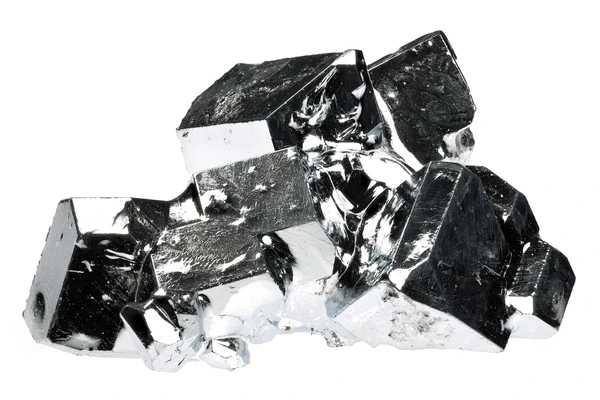
Introduction of Gallium Metal
Gallium is a unique metal with a melting point of 29.8°C, making it a liquid at or near room temperature. This property, combined with its low toxicity, negligible vapor pressure, and low viscosity, makes gallium an attractive material for various applications. However, gallium readily forms a thin oxide layer on its surface, which has been historically considered a nuisance. This review explores the properties and applications of gallium metal, highlighting the recent recognition of its oxide layer as an enabling feature.
Properties of Gallium Metal
- Oxide Layer Formation: Gallium forms a self-limiting, native oxide layer on its surface when exposed to oxygen. This solid oxide “skin” alters the physicochemical properties of the surface and influences the fluid dynamic behavior of the metal.
- Thermal and Electrical Conductivity: Gallium and its alloys have excellent thermal and electrical conductivities. They are suitable for applications like heat management, flexible electronics, and stretchable interconnects.
- Polymorphism and Undercooling: Gallium can exist in various polymorphic forms and exhibits undercooling behavior, allowing it to stay liquid below its melting point. This enables the formation of geometrically defined shapes and nanoparticles.
Production and Sources of Gallium Metal

Production Sources
Gallium is primarily obtained as a by-product from the processing of bauxite and zinc ores. The main sources of gallium include:
- Bauxite: Gallium is present in trace amounts (0.003-0.008%) in bauxite, the primary raw material for aluminum production. During the Bayer process for alumina production, gallium concentrates in the sodium aluminate liquor, which processors can further refine to recover gallium.
- Zinc ores: Gallium is present in sphalerite (zinc sulfide) ores at concentrations of 0.1-0.5%. Gallium accumulates in the leach solutions and residues during zinc’s hydrometallurgical processing, which can then be treated to extract the gallium.
Other potential sources include coal fly ash, industrial waste streams, and recycled materials like gallium arsenide (GaAs) semiconductors
Gallium Metal Manufacturing Methods
Extraction and Concentration
- Leaching of gallium-containing raw materials (bauxite, zinc residues) with acids or alkalis to obtain gallium-rich solutions.
- Solvent extraction, ion exchange, or precipitation techniques to concentrate and separate gallium from the leach solutions.
Purification
- Removal of impurities like iron, copper, and other metals through various techniques like cementation, sulfide precipitation, and solvent extraction.
- Electrolytic refining, vacuum distillation, and zone melting are employed to produce high-purity (99.999% or higher) gallium metal.
Specialized Techniques
- This process selectively volatilizes gallium as gallium chloride, which is subsequently reduced to recover gallium metal.
- Reduction melting reduces gallium-bearing materials with carbon or aluminum to produce crude gallium metal.
- In-situ synthesis directly produces gallium metal from powder mixtures through intensive vibrational mixing and melting.
Applications of Gallium Metal

Semiconductor Industry
- Gallium Arsenide (GaAs): Used in high-frequency electronics, microwave devices, and solar cells due to its high electron mobility and direct bandgap.
- Gallium Nitride (GaN): Employed in optoelectronics, high-power electronics, and blue/UV light-emitting diodes (LEDs) due to its wide bandgap and thermal stability.
- Gallium phosphide (GaP): Utilized in visible LEDs and semiconductor lasers.
Integrated Circuits and Electronics
- Manufacturers use gallium as a dopant in silicon-based integrated circuits to create p-type regions, improving contact resistance and thermal stability.
- Researchers are exploring gallium-based liquid metals for flexible electronics and stretchable circuits, due to their high electrical conductivity and self-healing properties.
Optoelectronics and Photonics
- Gallium-containing compounds like GaAs and GaN are essential for manufacturing high-efficiency solar cells, LEDs, laser diodes, and photodetectors.
- Gallium oxide (Ga2O3) is a promising material for UV detectors, power electronics, and transparent conductive oxides.
Energy Storage and Conversion
- Researchers are exploring these batteries for grid-scale energy storage due to their high energy density and low melting point.
- Manufacturers use gallium alloys in concentrated solar power systems and nuclear reactors for their high thermal conductivity and low melting point.
Metallurgy and Alloys
- Manufacturers use gallium in low-melting-point alloys, like gallium-indium-tin alloys, for soldering, thermal interface materials, and shape memory alloys.
- Researchers explore gallium-based liquid metals for self-healing coatings, lubricants, and thermal interface materials due to their unique properties.
Catalysis and Chemical Processing
- Manufacturers employ gallium compounds as catalysts in various organic synthesis reactions and hydrogenation processes.
- Gallium serves as a polycondensation catalyst in the production of polyethylene terephthalate (PET).
Biomedical Applications
Gallium-based compounds are investigated for potential applications in cancer treatment, antimicrobial agents, and medical imaging due to their unique properties.
Recycling and Recovery
Gallium can be recovered from various secondary sources, such as industrial waste, coal fly ash, and scrap materials, contributing to a sustainable supply chain.
Application Cases
| Product/Project | Technical Outcomes | Application Scenarios |
|---|---|---|
| Gallium Nitride (GaN) Power Electronics | GaN transistors offer higher breakdown voltages, faster switching speeds, and lower on-resistance compared to silicon, resulting in higher efficiency and power density. This enables smaller, lighter, and more efficient power conversion systems. | Electric vehicles, renewable energy systems, data centres, and industrial motor drives, where high-frequency, high-voltage operation and compact size are crucial. |
| Gallium Arsenide (GaAs) Monolithic Microwave Integrated Circuits (MMICs) | GaAs MMICs leverage the high electron mobility and direct bandgap of GaAs, enabling high-frequency operation, low noise, and high power density. This results in superior performance for microwave and millimetre-wave applications. | Telecommunications, radar systems, satellite communications, and automotive radar, where high-frequency signal processing and amplification are essential. |
| Gallium Nitride (GaN) Light-Emitting Diodes (LEDs) | GaN LEDs offer high brightness, energy efficiency, and long lifetimes due to GaN’s wide bandgap and thermal stability. They also enable efficient blue and ultraviolet light emission, enabling white light generation through phosphor coatings. | Solid-state lighting, display technologies, UV curing and disinfection systems, where energy-efficient and high-intensity light sources are required. |
| Gallium Arsenide (GaAs) Solar Cells | GaAs solar cells exhibit higher conversion efficiencies than silicon, particularly in concentrated photovoltaic (CPV) systems, due to their direct bandgap and superior radiation resistance. This results in higher energy yields and longer operational lifetimes. | Space applications, concentrated photovoltaic (CPV) systems, and high-efficiency terrestrial solar installations, where maximising energy output and durability are critical. |
| Liquid Gallium Alloys for Flexible Electronics | Liquid gallium alloys possess high electrical conductivity, self-healing properties, and stretchability, enabling the development of flexible, stretchable, and self-healing electronic circuits and interconnects. This allows for robust and conformable electronics for wearable and biomedical applications. | Wearable electronics, biomedical devices, soft robotics, and Internet of Things (IoT) applications, where flexibility, stretchability, and self-healing capabilities are advantageous. |
Latest innovations in Gallium Metal

- Gallium-based Liquid Metals (Ga-LMs):
- Ga-LMs exhibit unique optical properties like tunable plasmonic resonance due to their polymorphism, undercooling, and high mobility. They have potential applications in optical switches, sensors, light sources, micro/nano-robots, photoacoustic imaging, and metamaterials.
- Gallium Oxide (Ga2O3) Nanoparticles:
- Ga2O3 nanoparticles can be produced by firing gallium compounds in the presence of molybdenum or irradiating a gallium-reductant solution with ultrasonic waves. They find applications in lasers, phosphors, gas sensors, and next-generation power devices.
- Gallium-based Intermetallic Compounds:
- Intermetallic compounds with the general formula AnGam (where A is an alkali or alkaline earth metal) can be coated with a continuous gallium layer. These compounds are used as vapor sources in vacuum technologies.
- Complex Metal Oxides:
- Novel complex metal oxides containing alkali metals, gallium, and selenium have been developed. These materials exhibit non-linear optical properties and thermal stability, making them suitable for various applications.
Technical challenges
| Gallium-based Liquid Metal Optics | Exploring the unique optical properties of gallium-based liquid metals, such as tunable plasmonic resonance and characteristic responses due to polymorphism, undercooling, and high mobility, for applications in optical switches, sensors, light sources, and metamaterials. |
| Gallium Extraction from Secondary Resources | Developing efficient methods for extracting and recovering gallium from secondary resources like industrial waste, fly ash, and used electronic components, to meet the increasing demand for gallium in emerging technologies. |
| High-Purity Gallium Production | Advancing purification techniques, such as zone melting, vacuum distillation, and electrochemical methods, to obtain ultra-high purity gallium (99.99999% or higher) for applications in semiconductor and optoelectronic devices. |
| Gallium Oxide Synthesis | Exploring low-temperature and cost-effective methods for synthesizing gallium oxide (Ga2O3) nanoparticles and thin films for applications in lasers, phosphors, gas sensors, and next-generation power devices. |
| Gallium-based Liquid Metal Composites | Developing novel gallium-based liquid metal composites by incorporating metals, oxides, or other functional materials to enhance their properties and expand their applications in flexible electronics, catalysis, and energy storage. |
To get detailed scientific explanations of gallium metal, try Patsnap Eureka.

